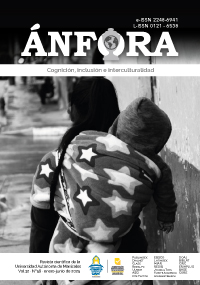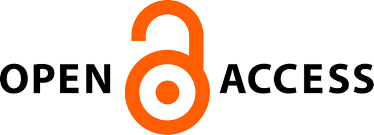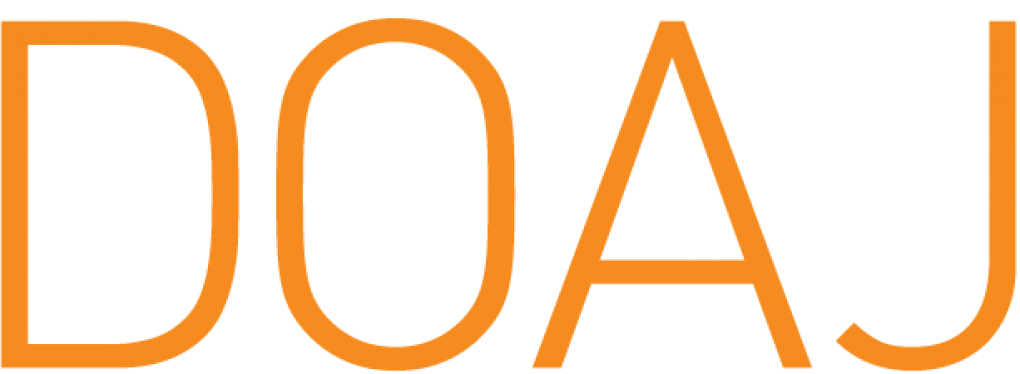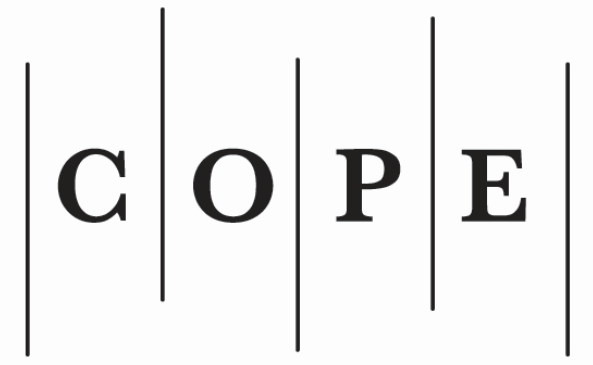Construction of Signed Speeches by Deaf University Students
Main Article Content
Abstract
Objective: This article aims to analyze the construction of signed speeches by Deaf university students (users of sign language) based on teaching systematization in the deepening cycle of Strengthening Colombian Sign Language (CSL) as a subject, between 2010 and 2020. The goal of this subject is to provide students with the tools to develop and enhance metalinguistic and metacognitive skills for creating academic discourses in CSL. Methodology: a qualitative approach was adopted. Analytical programs of the subject, in-depth interviews with the teacher in charge and papers by the students were analyzed. This analysis identified patterns and issues in CSL teaching. Results: the concept of visual text is introduced in Sign Language (SL) as an alternative to written text, essential in the context of the subject. In addition, theoretical foundations from metalinguistics and metacognition are established, and five didactic strategies to foster these skills in students are detailed. Conclusions:The importance of continuously strengthening metalinguistic processes in deaf students in order to improve their academic performance in higher education is emphasized, highlighting the need to generate specific teaching alternatives.
How to Cite
Downloads
Metrics
Article Details
deaf education, sign language, higher education, cognition
Alawajee, O. (2022). Exploring the Sign Language Proficiency of University Undergraduate Students in a Preservices Preparation Program for Teachers of Deaf Students. Higher Education Pedagogies, 7(1), 65-87. https://doi.org/10.1080/23752696.2022.2092882
Albalhareth, A., & Alasmari, A. (2023). Metacognitive Strategies Implemented with d/Dhh Students in Upper Elementary Schools in Saudi Arabia. En. Ed. Tezer, M. Metacognition in Learning - New Perspectives. IntechOpen. (Cap 15, PP 1-13) https://doi.org/10.5772/intechopen.113379
Ausbrooks, M., & Gentry, M. (2014). Exploring Linguistic Interdependence between American Sign Language and English through Correlational and Multiple Regression Analyses of the Abilities of Biliterate Deaf Adults. International Journal of English Linguistics, 4(1), 1-18. https://doi.org/10.5539/ijel.v4n1p1
Barreto, A. (2023). La inicialización en la lengua de señas colombiana (LSC): análisis a partir de un corpus espontáneo. Lenguaje, 51(1), 1-28. https://doi.org/10.25100/lenguaje.v51i1.12062
Barreto, A. y Cortés, Y. (2014). Aspectos relevantes del discurso en Lengua de Señas Colombiana (LSC). En Soler, S. y Calderón, D. (Eds.), Panorama de los estudios del Discurso en Colombia (pp. 245–281). Universidad Distrital Francisco José de Caldas.
Barreto-Muñoz, A. (2015). Fundarvid y Fenascol: notas sobres sus neologismos en la formación de la LSC. Jangwa Pana, 14(1), 99–112. https://doi.org/10.21676/16574923.1570
Benedict, K., Rivera, M., & Antia, S. (2015). Instruction in Metacognitive Strategies to Increase Deaf and Hard-of-Hearing Students’ Reading Comprehension. The Journal of Deaf Studies and Deaf Education, 20(1), 1-15. https://doi.org/10.1093/deafed/enu026
Berke, M. (2013). Reading Books With Young Deaf Children: Strategies for Mediating Between American Sign Language and English. The Journal of Deaf Studies and Deaf Education, 18(3), 299-311. https://doi.org/10.1093/deafed/ent001
Bermúdez, F. (2003). Reformulación teórica de los elementos fonológicos básicos en la lengua de señas colombiana. Forma y Función, 16, 98-108. https://repositorio.unal.edu.co/bitstream/handle/unal/30923/17254-54648-1-PB.pdf ?sequence=1&isAllowed=y
Borgna, G., Convertino, C., Marschark, M., Morrison, C., & Rizzolo, K. (2011). Enhancing Deaf Students’ Learning from Sign Language and Text: Metacognition, Modality, and the Effectiveness of Content Scaffolding. The Journal of Deaf Studies and Deaf Education, 16(1), 79-100. https://academic.oup.com/jdsde/article/16/1/79/419086
Buitrago, A., Camargo, A. y Rincón, L. (2021). Impacto del uso de rúbricas de autoevaluación y coevaluación sobre el desempeño escritural de docentes en formación. Folios, (55), 117-136. https://dialnet.unirioja.es/servlet/articulo?codigo=8213194
Burch, S. (2004). Capturing a Movement: Sign Language Preservation. Sign Language Studies, 4(3), 293-304. https://www.jstor.org/stable/26190751
Castro, V. (2017). Desarrollo de habilidades metacognitivas desde el área de Pensamiento Estratégico en estudiantes de la Universidad Católica de Temuco. Congresos CLABES (VII), 1-7. https://revistas.utp.ac.pa/index.php/clabes/article/view/1542/2280
Davidson, K., Lillo-Martin, D., & Pichler, D. (2014). Spoken English Language Development Among Native Signing Children With Cochlear Implants. The Journal of Deaf Studies and Deaf Education, 19(2), 238-250. https://doi.org/10.1093/deafed/ent045
Delmastro, A. (2010). El andamiaje metacognitivo en contextos de aprendizaje de una lengua extranjera. Didáctica. Lengua y Literatura, 22, 93-124. https://core.ac.uk/download/pdf/38833477.pdf
Emmorey, K. (2021). New Perspectives on the Neurobiology of Sign Languages. Frontiers in Communication, 6, 1-20. https://doi.org/10.3389/fcomm.2021.748430
Hall, M., Hall, W., & Caselli, N. (2019). Deaf Children Need Language, Not (Just) Speech. First Language, 39(4), 367-395. https://doi.org/10.1177/0142723719834102
Hall, W. (2017). What You Don’t Know Can Hurt You: The Risk of Language Deprivation by Impairing Sign Language Development in Deaf Children. Maternal and Child Health Journal, 21(5), 961-965.
https://doi.org/10.1007/s10995-017-2287-y
Hermans, D., Knoors, H., Ormel, E., & Verhoeven, L. (2008). The RelationshipBetween the Reading and Signing Skills of Deaf Children in Bilingual Education Programs. The Journal of Deaf Studies and Deaf Education, 13(4), 518-530. https://doi.org/10.1093/deafed/enn009
Herrera, J. (1997). Estrategias cognitivas y metacognitivas en la elaboración del mensaje escrito. Estudio bidireccional inglés-español, español-inglés [Tesis doctoral]. Servicio de publicaciones Universidad de La Laguna.
Howerton-Fox, A., & Falk, J. (2019). Deaf Children as ‘English Learners’: ThePsycholinguistic Turn in Deaf Education. Education Sciences, 9(2), 1-30. https://doi.org/10.3390/educsci9020133
Humphries, T., Mathur, G., Napoli, D. J., Padden, C., & Rathmann, C. (2022). Deaf Children Need Rich Language Input from the Start: Support in Advising Parents. Children, 9(11), 1-18. https://doi.org/10.3390/children9111609
INSOR. (2020). Caracterización de ciudadanos, usuarios y grupos de interés. Departamento Nacional de Planeación. https://colaboracion.dnp.gov.co/CDT/Programa%20Nacional%20del%20Servicio%20al%20Ciudadano/Guia%20de%20Caracterizaci%C3%B3n%20de%20Ciudadanos.pdf
Jarque, M. (2011). Lengua y gesto en la modalidad lingüística signada. Anuari de Filologia. Estudis de Lingüística, 1(1), 71-99. https://doi.org/10.1344/afel2011.1.4
Karchmer, M., & Mitchell, R. (2004). Chasing the Mythical Ten Percent: Parental Hearing Status of Deaf and Hard of Hearing Students in the United States. Sign Language Studies, 4(2), 138–163. https://doi.org/10.1353/sls.2004.0005
Ladd, P. (2011). Comprendiendo la cultura sorda: en búsqueda de la sordedad. Consejo Nacional de la Cultura y las Artes, Fondo Nacional de Fomento del Libro y la Lectura.
Lillo-Martin, D., & Hochgesang, J. (2022). Signed Languages – Unique and Ordinary: A Commentary on Kidd and García (2022). First Language, 42(6), 789-793. https://doi.org/10.1177/01427237221098858
López, B. (2015). Estrategias didácticas metacognitivas para el desarrollo de la comunicación oral y escrita. En Morimoto, M. V. Pavón y R. Snatamaría (Eds.), La enseñanza de ELE centrada en el estudiante (pp. 911-922). XXV
Congreso Internacional ASELE. https://dialnet.unirioja.es/servlet/articulo?codigo=5426227
Marschark, M., & Knoors, H. (2012). Educating Deaf Children: Language, Cognition, and Learning. Deafness y Education International, 14(3), 136-160. https://doi.org/10.1179/1557069x12y.0000000010
Martínez, D., Barreto, A., Corredor, A. y Acevedo, S. (2018). Formación en Lenguaje de Señas Colombiana: una sistematización de la experiencia de FENASCOL. Sello Editorial UNAD.
Mayberry, R., Giudice, A. del & Lieberman, A. (2011). Reading Achievement in Relation to Phonological Coding and Awareness in Deaf Readers: A Metaanalysis. The Journal of Deaf Studies and Deaf Education, 16(2), 164–188.
https://doi.org/10.1093/deafed/enq049
Mayberry, R., & Lock, E. (2003). Age Constraints on First Versus Second Language Acquisition: Evidence for Linguistic Plasticity and Epigenesis. Brain and Language, 87(3), 369-384. https://doi.org/10.1016/s0093-934x(03)00137-8
McCutchen, D. (2011). From Novice to Expert: Language and Memory Processes in the Development of Writing Skill. Journal of Writing Research, 3(1), 51-68. https://doi.org/10.17239/jowr-2011.03.01.3
Oviedo, A. (2001). Apuntes para una gramática de la Lengua de Señas Colombiana. Instituto Nacional para Sordos y Universidad del Valle.
Pinto, M., Iliceto, P., & Melogno, S. (2012). Argumentative Abilities in Metacognition and in Metalinguistics: A Study on University Students. European Journal of Psychology of Education, 27(1), 35-58. https://www.jstor.org/stable/43551085
Rodríguez, N., Delgado, E., Galvis, R., Jutinico, S., Monroy, E. y Pabón, M. (2009). Manos y Pensamiento: Inclusión de estudiantes Sordos a la vida universitaria.
Socialización y réplica de la experiencia. Editorial Universidad Pedagógica Nacional. Rodríguez, N., Pabón, M., Alfonso, G., Avendaño, L. y Martínez, P. (2021). Proyecto “Manos y pensamiento: inclusión de estudiantes Sordos a la
vida universitaria”. En UPN (Ed.) Itinerarios de Investigación Educativa y Pedagógica (pp. 317-324). UNP. https://doi.org/10.17227/di.2021.1676
Rojas, V., Méndez, O. y Gutiérrez, M. (2019). Potenciación de la conciencia crítica de docentes en formación Sordos de la UPN a través del cine foro. Aletheia. Revista de Desarrollo Humano, Educativo y Social Contemporáneo, 11(1), 69-88. https://doi.org/10.11600/21450366.11.1aletheia.69.88
Rosenstock, R. (2008). The Role of Iconicity in International Sign. Sign Language Studies, 8(2), 131–159. http://www.jstor.org/stable/26190640
Rosenthal, A. (2009). Lost in Transcription: The Problematics of Commensurability in Academic Representations of American Sign Language. Text y Talk - An Interdisciplinary Journal of Language, Discourse y Communication Studies,
29(5), 595-614. https://doi.org/10.1515/text.2009.031
Safar, J., Guen, O., Collí, G., & Hau, M. (2018). Numeral Variation in Yucatec Maya Sign Languages. Sign Language Studies, 18(4), 488-516. https://doi.org/10.1353/sls.2018.0014
Schick, B., Villiers, P., Villiers, J., & Hoffmeister, R. (2007). Language and Theory of Mind: A Study of Deaf Children. Child Development, 78(2), 376-396. https://doi.org/10.1111/j.1467-8624.2007.01004.x
Shantie, C., & Hoffmeister, R. (2000). Why Schools for Deaf Children Should Hire Deaf Teachers: A Preschool Issue. Journal of Education, 182(3), 42-53. https://doi.org/10.1177/002205740018200304
Sánchez, C. (1990). La increíble y triste historia de la sordera. CEPROSORD Singleton, J., & Newport, E. (2004). When Learners Surpass Their Models: The Acquisition of American Sign Language from Inconsistent Input. Cognitive Psychology, 49(4), 370-407. https://doi.org/10.1016/j.cogpsych.2004.05.001
Schunk, D., & Zimmerman, B. (2011). Handbook of Self-regulation of Learning and Performance. Taylor y Francis.
Strong, M., & Prinz, P. (1997). A Study of the Relationship Between American Sign Language and English Literacy. The Journal of Deaf Studies and Deaf Education, 2(1), 37-46. https://doi.org/10.1093/oxfordjournals.deafed.a014308
Tarazona, A. (2003). Entre la integración y la diferenciación: La lucha por la reivindicación de los Sordos como comunidad lingüística en Colombia [tesis de grado]. Universidad de Los Andes, Bogotá, Colombia. https://repositorio.uniandes.edu.co/entities/publication/8a1e3acd-4f47-47c9-ad67-66739666e512
Tomaszewski, P., Krzysztofiak, P., & Moroń, E. (2019). From Sign Language to Spoken Language? A New Discourse of Language Development in Deaf Children. Psychology of Language and Communication, 23(1), 48-84. https://doi.org/10.2478/plc-2019-0004
Varela, J., Huerta, C. y Tello, O. (2017). Apuntes para una teoría de la lengua de señas. Conductual, Revista Internacional de Interconductismo y Análisis de Conducta, 2(5), 79-98. https://doi.org/10.59792/sfgt8992
Wang, Z., & Chen, G. (2018). Discourse Performance in L2 Task Repetition. In M. Bygate (Ed.), Learning Language through Task Repetition (pp. 97–116). John Benjamins Publishing Company. https://doi.org/10.1075/tblt.11
Wurm, S. (2018). From Writing to Sign: An Investigation of the Impact of Text modalities on translation. Translation and Interpreting Studies, 13(1), 130-149. https://doi.org/10.1075/tis.00008.wur

This work is licensed under a Creative Commons Attribution-NonCommercial-ShareAlike 4.0 International License.
Once the manuscript is approved, the authors should file and sign the Right Transfer Format.


 https://orcid.org/0000-0003-0045-1242
https://orcid.org/0000-0003-0045-1242










